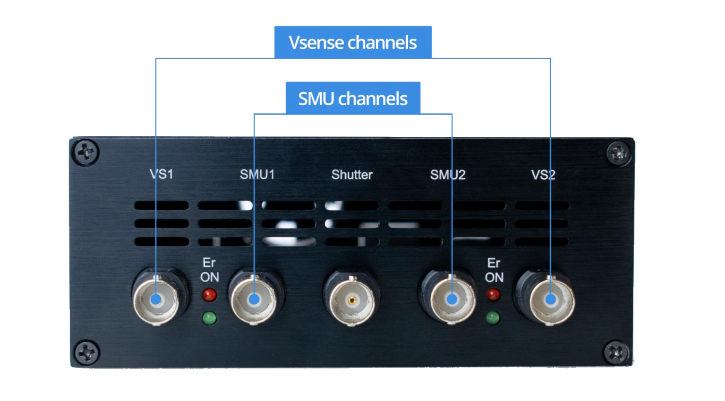What Are The Channels On The Source Measure Unit For?

The Ossila Source Measure Unit is designed to test and measure small devices/films which operate between 10V to -10V, and can measure currents up to 200 mA. Potential applications include solar cell characterization, OLED testing, measuring certain battery properties, FET characterization and much more.
The system has five channels: two SMU channels, two VSense (voltage measurement) channels, and a shutter channel.

Source Measure Unit Channels
A source measure unit is a combination of a stable DC power supply and a multimeter in one device. SMUs are generally considered preferrable over a combination of output and measurement devices due to the versatility and precision one has in a combined unit.
The Ossila SMU channels can individually or simultaneously:
- Source voltage (between 10 V and-10 V)
- Measure voltage (between 10 V and-10 V)
- Measure current (up to 200 mA)
This is vital for measuring I-V curves, helping to characterize diodes or diode like devices (such as solar cells, OFETs, OLEDs, etc).
Why Measure and Source Voltage?
The output voltage is always measured at the output of the BNC (rather than assuming it is at the set voltage) in case of any load effects reducing the actual experienced voltage. The SMU channels on the Ossila Source Measure Unit can supply and measure a voltage of ±10 V and can measure ±200 mA.
Defining Current Range
The current measurement of the SMU channel is spread over 5 ranges. Each range has a different maximum current, accuracy, and resolution.
As the range number increases, the maximum measurable current decreases, but the accuracy and resolution increase.
Choosing Measurement Speed
The SMU channels have 10 different speed/ resolution combinations. The measurement speed is related to the Sample Per Point value (or oversampling rate - OSR) defines the number of repeat measurements taken and averaged for each data point.
Increasing the sampling rate of a measurement will increase the accuracy, precision, and resolution, but increase the measurement time.
However, decreasing the measurement time will decrease the accuracy, precision and resolution of the measurement.
Choosing the right options allows you to prioritize certain characteristics, tailoring the measurement parameters to your experiment.
VSense Channels
You should only use the VSense channels to measure an external voltage. The SMU channels can only measure the voltage which they themselves source. The SMU channels should not be used to measure any external voltage as this risks damaging the device.
Any voltage measurement of a voltage not sourced by the SMU itself is done through the VSense channels. For example, measuring the voltage of a battery should use the VSense channels.
The VSense channels can measure voltages between 10 V and -10 V, with an accuracy of 10 mV.
Shutter Channel
The Shutter/Trigger can be used either as an input or an output. It can be used to send a trigger signal to other instruments or configured to wait for a trigger from other instruments. This enables the Ossila Source Measure Unit to integrate with other components.
Source Measure Unit

Contributing Authors
Written by
Product Specialist
Battery Measurement by
Scientific Writer